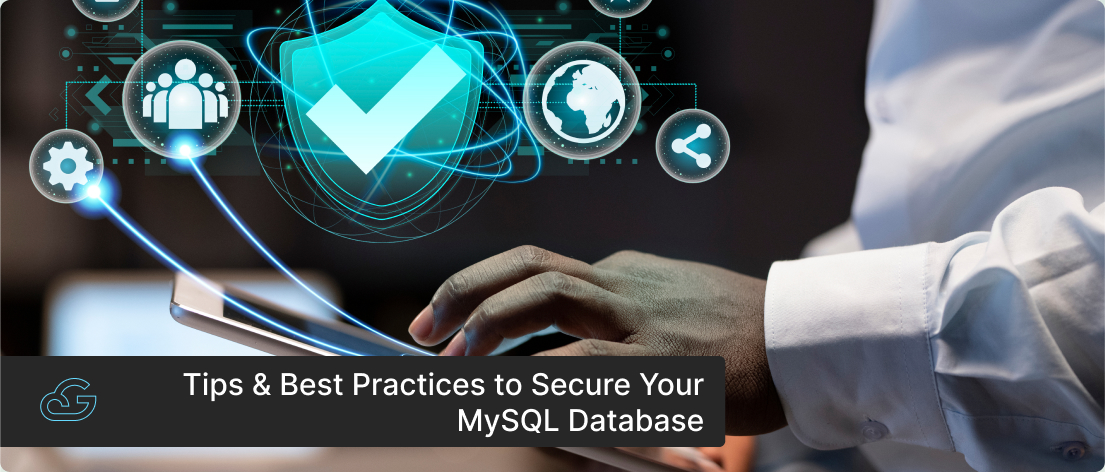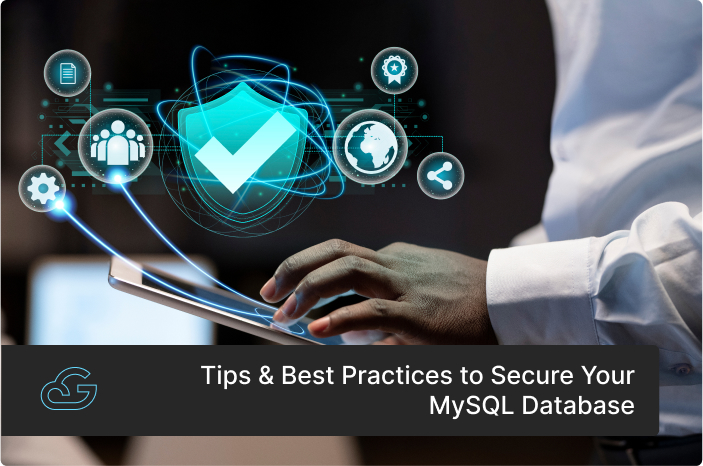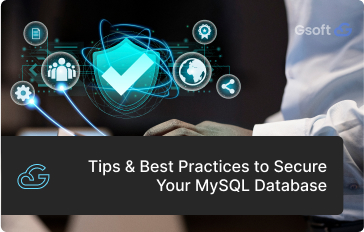Blogs / MySQL
Tips & Best Practices to Secure Your MySQL Database
By
Siju Vincent
Posted: February 23, 2024
• 7 Minutes 40 Seconds
Databases are vital for modern-day organizations. They facilitate the storage, access, and management of data, enabling businesses to operate efficiently. However, what will happen if someone can gain access to these databases and tamper with the information stored in them?
The implications of a breach where cybercriminals gain access to sensitive databases extend far beyond mere financial loss, resulting in irreparable damage to the reputation and trust for organizations. And according to recent industry reports, ransomware attacks are on the rise. In the first half of 2023 alone, attackers extorted nearly 450 million USD. In the midst of this cybersecurity crisis, it is important that organizations prioritize safeguarding their databases.
This blog post aims to shed light on the importance of database security while providing crucial insights for fortifying MySQL databases.
Why is Database Security Important?
Databases are used for managing some of the most sensitive and critical information. For instance, a company operating in the BFSI sector could utilize a database system to collect their customers’ transaction details for credit risk calculation. Similarly, a healthcare organization might use a database system to analyze patient data for creating personalized treatment plans. Therefore, organizations need to take database security seriously.
But, securing a database system is not an easy task. One of the major reasons behind it is the rapid pace of technological evolution. Most advanced technological innovations - AI, ML, etc. - require database management systems to produce optimal results. As the number of users and usage frequency increase, the chances of an attack exponentially spikes up. And traditional security measures are not sustainable enough to meet the sophisticated security demands of modern databases.
Furthermore, there are numerous ways in which threat actors or cybercriminals can gain access to a database system. Let’s examine some of the most common ones closely.
-
SQL Injection Attacks:
- An SQL injection attack occurs when a threat actor inserts malicious codes or commands into an application to gain access to its database.
- Once attackers gain access to the database, they can read sensitive data from the database, modify the data, and even execute administration operations.
-
Distributed Denial of Service (DDoS):
- In this form of cyberattack, threat actors use multiple accounts to overload the database with fake queries.
- The goal behind DDOS attacks is to slow down the database by disrupting the normal traffic on a server, service, or network, eventually leading to a total shutdown.
-
Account Access Mismanagement:
- Mismanagement of account access involves situations where user accounts are not properly managed, leading to unauthorized access to sensitive information.
- This internal threat often occurs when database administrators fail to follow the principle of least privilege and give users powerful privileges like access to root accounts.
-
Remote Pre-Authentication User Enumeration:
- Remote pre-authentication user enumeration is a vulnerability that allows attackers to determine valid user accounts on a system or network service without having to authenticate or provide any credentials.
- This can significantly aid attackers in planning targeted attacks or exploiting other vulnerabilities.
The threats listed here are the most prominent ones. We must acknowledge that there exist many other internal and external vulnerabilities like weak passwords, insecure configurations, race conditions, and much more. They can also pose serious risks to the integrity and confidentiality of databases.
But now we must shift focus to the main section of our blog post - top 10 tips and best practices to secure your MySQL database. These tips and best practices are designed to help companies fortify their database defenses and mitigate the risks posed by cybercriminals.
Top 10 Tips & Best Practices to Secure Your MySQL Database
-
Use Strong Passwords & Change Passwords Periodically:
-
Follow the Principle of Least Privilege:
-
Minimize Remote Access:
- Limit network access to only what is necessary for database operations. This reduces the potential attack surface and lowers the risk of unauthorized access.
- Monitor and control remote access by users, especially in production environments.
- Ensure that only authorized personnel can access the database remotely and track their activities for security purposes.
- Disable unnecessary remote access if the MySQL database is only used by local applications.
-
Get Rid of Default Accounts, Port Mappings, and Other Settings:
- Delete the default test database: The test database is accessible to all users by default, which makes it an easy target for threat actors.
- Delete anonymous default accounts: MySQL creates anonymous accounts during installation, which are potential avenues for cybercriminals to access the database.
- Change default port mappings: MySQL’s default port (3306) is often targeted by attackers. Changing it post-installation makes it difficult for attackers to locate and exploit the database.
-
Conduct Proper Auditing & Monitoring:
- Monitor the server configuration and database schemas to ensure system integrity and security.
- Capture and analyze changes made to the database to track data modifications.
- Keep a close eye on users accessing the database to filter out unauthorized users and suspicious activities.
- Monitor log-in attempts to detect any unusual log-in patterns or unauthorized access attempts.
- Assess password strength regularly.
-
Encrypt Data at Rest:
-
Encrypt Data in Transit:
-
Set Up Regular Backups & Disaster Recovery:
- Schedule automated backups using tools like mysqldump, mysqlpump, or MySQL Enterprise Backup.
- Store backups in an offsite location or use cloud storage to protect against physical disasters.
- Regularly test the backup and recovery procedures.
- Implement redundancy measures, such as replication or clustering, to create multiple copies.
-
Choose Trusted Cloud Providers:
- Identify a cloud provider with robust security features, identity and access management capabilities, network security controls, and compliance certifications.
- Make sure that the cloud provider complies with data residency regulations and industry standards.
- Evaluate the cloud service provider’s monitoring and logging capabilities.
- Ensure that the cloud provider keeps their infrastructure and services up-to-date with the latest security patches and updates.
One of the basic measures that users must take to secure their MySQL database is using strong and unique usernames and passwords for all accounts. Users must make sure to use passwords that are at least 15 characters long, containing a mixture of lowercase and uppercase letters, numbers, and symbols.
MySQL also allows provisions to apply password policies that will demand periodic password changes. This way, it will be difficult for threat actors to decrypt passwords, as they will keep changing at specific points in time.
The principle of least privilege has a vital role to play in securing MySQL databases. By applying it, companies can limit user access. That is, it ensures that every user is given just enough privileges to do their work within the database. This minimizes the potential damage even if one user’s account is compromised.
Accessing databases through remote network connections exposes them to cyber threats. Therefore, it is vital to implement tight control over it. By doing so, companies can safeguard their sensitive data and mitigate security risks.
Follow these key principles to minimize remote access effectively:
When setting up a MySQL database, it is important to change or remove the default configurations provided during installation. Here are some of the key actions to consider:
Additionally, it is also important to delete the MySQL history file, as it contains the record of all commands executed on the server, including sensitive information like passwords.
Keeping track of database activity through access logs is crucial for maintaining security and compliance standards. Access logs provide valuable insights into who is accessing your data and the actions they are performing, essential for both reporting and security investigations. Compliance laws like HIPAA, GDPR, and CPRA mandate such audits, and non-compliance can result in significant fines.
In addition to meeting legal requirements, it is essential to audit and monitor the following:
Encrypting data at rest is the process of securing sensitive information stored on physical storage mediums like a host computer or any device hosting a database. With this, companies can encrypt files such as log files, data files, etc., and ensure that even if users gain access to the physical medium, they cannot decipher the data without the keys.
One of the most popular data at rest encryption methods is Transparent Data Encryption (TDE). TDE is an encryption mechanism that involves securing the data at the file or volume level. It facilitates total database encryption or specific tables/columns encryption without demanding any application code changes. MySQL enables TDE through its default storage engine - InnoDB, which can encrypt files and log files transparently.
Like encrypting data at rest, companies must also focus on securing the data in transit. That is, encrypting the communication channels or networks through which data is traveling between systems or devices.
One of the widely used methods for encrypting data in transit involves integrating SSL/TSL (Secure Sockets Layer/Transport Layer Security) protocols. These protocols help establish a secure communication channel between a client and a server, thereby securing the data and preventing eavesdropping and man-in-the-middle attacks.
Regular backups and disaster recovery are crucial elements of a database management system. In the event of data loss or corruption, they enable the effective restoration of the database to its previous state.
Consider the following steps to ensure robust backup and disaster recovery solutions:
By running the MySQL database in a cloud environment, the cloud provider assumes responsibility for its security. Major cloud providers come with inbuilt features and mechanisms for securing the network, monitoring and auditing, etc. For instance, AWS offers the AWS shield to protect database instances from DDoS attacks. Likewise, Azure uses Microsoft Defender to spot suspicious behavior.
Before selecting a cloud service provider, consider the following factors:
Secure Your MySQL Database with Gsoft Cloud
Gsoft Cloud offers the best managed MySQL database services. We combine our extensive knowledge of cloud technology with our technical acumen to augment MySQL databases. Our experts collaborate with clients in deploying, managing, and optimizing MySQL databases while helping them identify the optimal cloud platform and architecture that matches their security needs and compliance concerns.
Partner with us to:
- Establish a MySQL database tailored for your applications.
- Mitigate security threats and risks.
- Comply with data security regulations.
- Obtain quick incident response.
- Set up effective data backup and disaster recovery mechanisms.
Summary
Cybercriminals are becoming smarter with each passing day. And it is important for companies to implement robust security mechanisms to ward them away. However, securing a database requires a comprehensive effort beyond just technical controls.
What is needed is a cultural shift and organizational realignment for making database security a high priority across teams - from executive leadership setting policy to developers building applications and administrators managing infrastructure. With shared vigilance, a resilient security posture, and collective responsibility, companies can stay a step ahead of threats in the evolving landscape.
Looking to fortify your MySQL database defense? Reach out to us today at www.gsoftcomm.net.


Get Know More About Our Services and Products
Reach to us if you have any queries on any of our products or Services.











